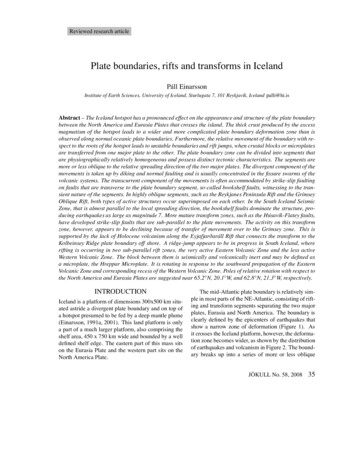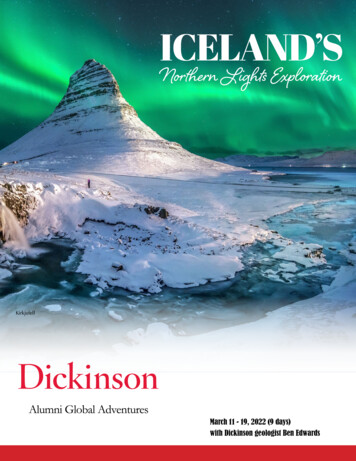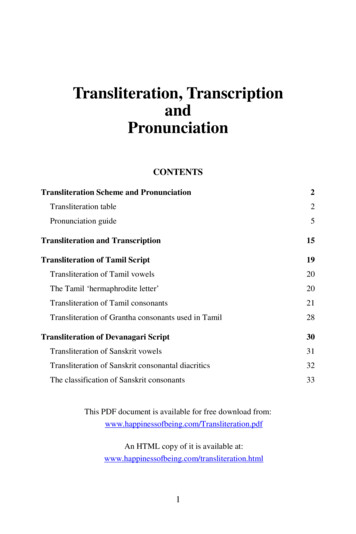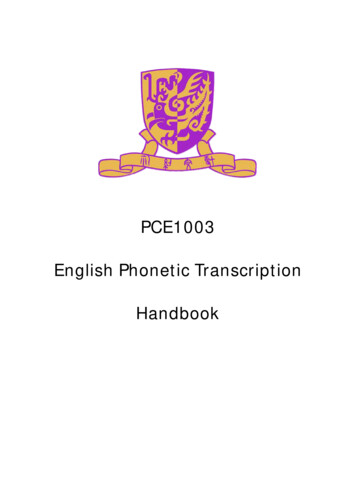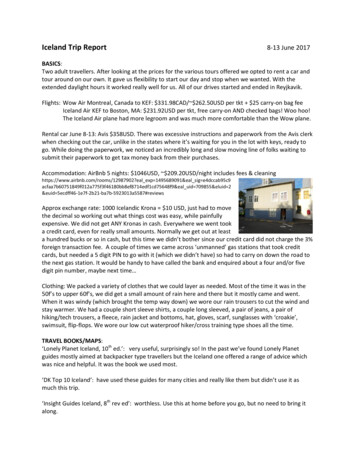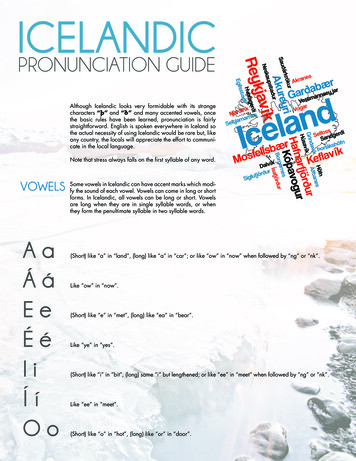
Transcription
ICELANDICPRONUNCIATION GUIDEAlthough Icelandic looks very formidable with its strangecharacters “þ” and “ð” and many accented vowels, oncethe basic rules have been learned, pronunciation is fairlystraightforward. English is spoken everywhere in Iceland sothe actual necessity of using Icelandic would be rare but, likeany country, the locals will appreciate the effort to communicate in the local language.Note that stress always falls on the first syllable of any word.VOWELSAaÁáEeÉéIiÍíOoSome vowels in Icelandic can have accent marks which modify the sound of each vowel. Vowels can come in long or shortforms. In Icelandic, all vowels can be long or short. Vowelsare long when they are in single syllable words, or whenthey form the penultimate syllable in two syllable words.(Short) like “a” in “land”, (long) like “a” in “car”; or like “ow” in “now” when followed by “ng” or “nk”.Like “ow” in “now”.(Short) like “e” in “met”, (long) like “ea” in “bear”.Like “ye” in “yes”.(Short) like “i” in “bit”, (long) same “i” but lengthened; or like “ee” in “meet” when followed by “ng” or “nk”.Like “ee” in “meet”.(Short) like “o” in “hot”, (long) like “or” in “door”.
ÓóUuÚúYyÝýÆæÖöLike “o” in “snow”.(Short) like “u” in “put”, (long) the same short “u” but lengthened; or like “oo” in “moon” when followedby “ng” or “nk”.Like “oo” in “moon”.Same as Icelandic “i”: (short) like “i” in “bit”, (long) same “i” but lengthened; or like “ee” in “meet” whenfollowed by “ng” or “nk”.Same as Icelandic “í”: like “ee” in “meet”.Like “i” in “mile”.(Short) like “ur” in “fur” but shorter, (long) like “ur” in “fur”; (do not pronouce the “r”).CONSONANTSBbDdÐðFfGgAlways like “p” in “speak”.Always like “t” in “sting”.Like “th” in “that”, (only occurs in word middle and word end).Like “f” in “fish”, or like “v” in “van” when between vowels; or when before “l” or “n”,like “p” in “speak”.Like “k” in “skill”, but similar to Hungarian “ty” when before e, i, æ, j, or y; it is lost after “á”, “ó”,“u” when followed by “a” or “u” in the next syllable or when at word end.
HhJjKkLlMmNnPpRrSsTtVvXxÞþLike “h” in “hat”, or like “k” when before a consonant; (never silent like “honour”).Like “y” in “yes”.Like “k” in “kill” when word-initial, but similar to Hungarian “ty” with a puff of air when before e, i, æ,j, or y as word-initial; otherwise like the usual case for “g”.Like “l” in “like”.Like “m” in “me”.Like “n” in “nurse”.Like “p” in “push” when word-initial, or like “f” in “far” when before “s”, “k”, or “t”; otherwise pronouncedlike “b”Rolled, like Scottish “r”.Like “s” in “sun”; (never like “z” in “zero”).Like “t” in “take”.Like “v” in “value”.Like “x” in “axe”.Like “th” in “thing” (never occurs at the end of a word).
COMMON DIPHTHONGS AND LETTER COMBINATIONSauei, eygi, gjhvkkllngnnpprlrnttLike “ur” in “fur” (do not prononce the r) followed by “ee” in “see” but with no intervening “r” - “u(r)-ee”,similar to “oy” in “boy”.Like “ay” in “say”.Like “gy” in “drag-you” at word start; like “y” in “yes” in word middle or at word end.Like “kv” in “lock vent”.Like “chk” in Scottish “Loch Carron”.Like “tl” in “settle”. Similar to Welsh “ll” (double L) but more aspirated (has more air to it).Like “nk” in “thinker”, not “ng” in “finger”.Like “dn” in “hard-nosed” when after “á”, “é”, “í”, “ó”, “ú”, “ý”, “æ”, “au”, “ei”, or “ey”; or like“nn” in “tunnel” after “a”, “e”, “i”, “o”, “u”, “y” or “ö”.Like “h” and “p” fused together, similar to “hop” without the “o”.Like “dl” in “riddle” similar in form to Welsh “ll” (double L) but said harder.Like “dn” in “hard-nosed” when after “á”, “é”, “í”, “ó”, “ú”, “ý”, “æ”, “au”, “ei”, or “ey”.Like “h” and “t” fused together, similar to “hut” without the “u”.
PHRASE LISTNOTE: you should take time to learn the alphabet rather than rely on the pronunciation guides within the brackets. Also note,the hyphens (-) serve only as a means to help you break down pronunciations, they do not represent where a pause shouldbe, and the pronunciation should be read without pausing on the hyphens.Hello.Halló. (Hah-low)Hello (informal, to a man).Sæll. (Sight-l.)Hello (informal, to a woman).Sæl. (Sigh-l.)Hello (informal, to a woman).Sæl. (Sigh-l.)Hi.Hæ. (High.) Like the English word.How are you?Hvað segirðu gott? (Kvadh sek-ir-dhu goht?)Fine, thank you.Ég segi allt gott, þakka þér fyrir. (Yeh sek-i atlt goht, thah-ka thyer fi-rir.)
Nice to meet you.Komdu sæll, (to a man). (Komdu sight-l.)Komdu sæl, (to a woman). (Komdu sighl.)Please.Gjörðu svo vel, (to one person). (Gyer-dhu svo vel.)or Gerið þið svo vel, (to many people). (Ger-adh thi-dh svo vel.)Thank you.Þakka þér fyrir. (Thah-ka thyer fi-rir.)Thanks (informal)Takk. (Tahk.)You’re welcome.Ekkert að þakka. (Eh-kehrt adh thah-ka.)Yes.Já. (Yaw.)or Jú (Yoo; for answering a negative question).No.Nei. (Nay.)Excuse me, (getting attention).Afsakið. (Av-sak-idh.)
Excuse me, (begging pardon).Fyrirgefðu. (Fi-rir-gyev-dhu.)I’m sorry, (didn’t hear).Ha? (Ha?)or Hvað segir þú? (Kvadh se-kir thoo?)I’m sorry, (regretful).Því miður. (Thvee mi-dhur.)Goodbye, (informal).Bless. (Bless; often said twice, “Bless bless”.)I can’t speak Icelandic [well].Ég tala ekki íslensku [svo vel]. (Yeh ta-la eh-ki ees-len-sku [svo vel].)Do you speak English?Talarðu ensku? (Ta-lar-dhu en-sku?)Is there someone herewho speaks English?Er einhver hér sem talar ensku? (Er ayn-kver hyer sem ta-lar en-sku?)Help!Hjálp! (Hyawlp!)
Look out!Varúð! (Va-rooth!)Good morning.Góðan daginn. (Goh-dhan da-kin.)Good night.Góða nótt. (Goh-dha no-ht.)Good night, (to sleep).Sofðu vel. (So-vdhu vel.)I don’t understand.Ég skil ekki. (Yeh skil eh-ki.)Could you speak more slowly?Gætirðu talað hægar? (Gigh-tir-dhu ta-ladh high-kar?)How do you sayin Icelandic?Hvernig segir maður á íslensku? (Kver-nik se-kir ma-dhur ow ees-len-sku?)OK.Allt í lagí. (Atlt ee lak-i.)or Ókei (Oh-kay; this is used amongst younger generations.)
Where is the toilet?Hvar er klósettið? (Kvar er klow-sett-idh?)Leave me alone.Farðu í burtu. Or just “farðu” (Fa-r thu i bur-tu.)Don’t touch me!Ekki snerta mig! (E-kki snert-a mig.)I’ll call the police.Ég kalla á lögregluna. (Ye kat-la a lurk-rek-luna.)Police!Lögregla! (Lurk-rek-la!)Stop! Thief!Stopp! Þjófur! (Sto-hp! Thyoh-vur!)I need a little help.Ég þarf smá hjálp. (Ye tharf sm-ow hjowlp.)It’s an emergency.Það er áríðandi. (Thadh er ow-ree-th-an-ti.)I’m lost.Masculine: Ég er týndur. (Yeg er teen-tur.) Feminine: Ég er týnd (“Yeg er teen-t)
My bag is missing.Taskan mín er týnd. (Tas-kan meen er teen-ed.)My wallet is missing.Seðlaveskið mitt er týnt. (Sedh-la-ves-kidh mi-ht er teent.)My (coin)purse is missing.Buddan mín er týnd. (Buh-tan meen er teen-ed.)I’m sick.Masculine: Ég er veikur. (Yeg er vai-kur.).Feminine: Ég er veik (“Yeg er vai-k”)I’ve been injured.Ég er særður. (Yeg er sair-thur.)I need a doctor.Ég þarf lækni. (Yeg tha-rf lai-kni.)Can I use your phone?Má ég nota símann þinn? (Mao yea not-a see-marn thin?)With thanks to Wikitravel
PRONUNCIATION GUIDE VOWELS Although Icelandic looks very formidable with its strange characters “þ” and “ð” and many accented vowels, once the basic rules have been learned, pronunciation is fairly straightforward. English is spoken everywhere in Iceland so the ac
